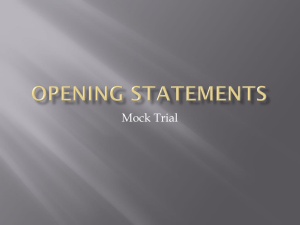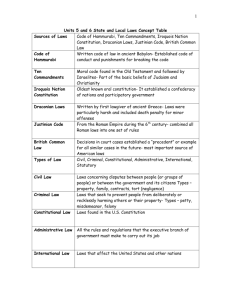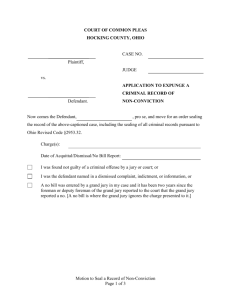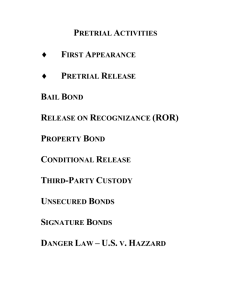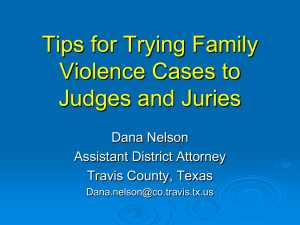Stages in a Criminal Case - Texas District & County Attorneys
advertisement
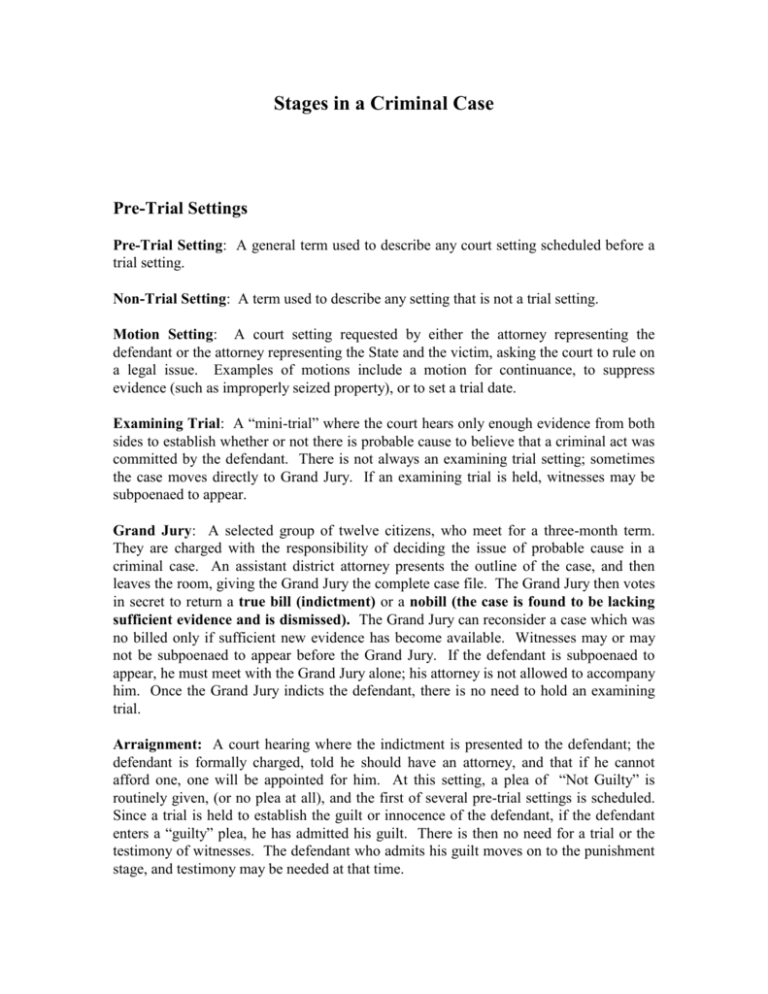
Stages in a Criminal Case Pre-Trial Settings Pre-Trial Setting: A general term used to describe any court setting scheduled before a trial setting. Non-Trial Setting: A term used to describe any setting that is not a trial setting. Motion Setting: A court setting requested by either the attorney representing the defendant or the attorney representing the State and the victim, asking the court to rule on a legal issue. Examples of motions include a motion for continuance, to suppress evidence (such as improperly seized property), or to set a trial date. Examining Trial: A “mini-trial” where the court hears only enough evidence from both sides to establish whether or not there is probable cause to believe that a criminal act was committed by the defendant. There is not always an examining trial setting; sometimes the case moves directly to Grand Jury. If an examining trial is held, witnesses may be subpoenaed to appear. Grand Jury: A selected group of twelve citizens, who meet for a three-month term. They are charged with the responsibility of deciding the issue of probable cause in a criminal case. An assistant district attorney presents the outline of the case, and then leaves the room, giving the Grand Jury the complete case file. The Grand Jury then votes in secret to return a true bill (indictment) or a nobill (the case is found to be lacking sufficient evidence and is dismissed). The Grand Jury can reconsider a case which was no billed only if sufficient new evidence has become available. Witnesses may or may not be subpoenaed to appear before the Grand Jury. If the defendant is subpoenaed to appear, he must meet with the Grand Jury alone; his attorney is not allowed to accompany him. Once the Grand Jury indicts the defendant, there is no need to hold an examining trial. Arraignment: A court hearing where the indictment is presented to the defendant; the defendant is formally charged, told he should have an attorney, and that if he cannot afford one, one will be appointed for him. At this setting, a plea of “Not Guilty” is routinely given, (or no plea at all), and the first of several pre-trial settings is scheduled. Since a trial is held to establish the guilt or innocence of the defendant, if the defendant enters a “guilty” plea, he has admitted his guilt. There is then no need for a trial or the testimony of witnesses. The defendant who admits his guilt moves on to the punishment stage, and testimony may be needed at that time. Elements of a Trial The trial is the most effective method our society has devised to settle disputes among people. A trial is a method of gathering facts and drawing a conclusion for those facts while operating under a procedural code. In a jury trial, the jury must believe beyond a reasonable doubt that the accused committed the crime with which he is charged. The standard means that a member of the jury must have no reasonable doubts about the defendant’s guilt. If a juror does have a reasonable doubt, the juror must vote “not guilty”. The progress of the trial is as follows: The defendant is read the charges by the judge and pleads “ not guilty”. The defense attorney and the prosecutor (an assistant district attorney) question prospective jurors and select those who will become jury members. This process is called Voir Dire or Jury Selection. The prosecutor representing the State and the victim, makes an opening statement, outlining the case to be established. The prosecution calls its witnesses, and through their testimony, offers evidence. The defense may then cross-examine the State’s witnesses, after the State has concluded the direct examination. After the defense concludes the cross exam, the State may then ask the witnesses additional questions on re-direct examination. Finally, the defense may further question the State’s witnesses on re-cross examination. When the State has concluded its case, or rested, the defense, representing the defendant, makes its opening statement, and puts on its evidence and witnesses. The same procedure is followed in questioning the defense witnesses as described above concerning the state’s witnesses. When the defense has concluded its case, or rested the prosecution and defense then offer their final arguments to the jury. The victim and other witnesses may come back into the courtroom to hear this summation. If a jury trial, the jury then retires to deliberate the guilt of innocence of the defendant. If the defendant is convicted by the jury, then both the defense and the prosecution present evidence in the punishment phase. The jury then will deliberate on the punishment for the defendant. Texas has a bifurcated trial system. The trial is held in two stages: the guilt stage and the punishment stage. The jury must be unanimous in its decision. If the jury cannot agree on a verdict a mistrial results in the form of a hung jury. A case may also result in a mistrial if the judge so rules on a procedural error. If the defendant is found not guilty, there will not be a re-trial. The rule of double jeopardy prohibits the accused from being tried twice for the same offense (with some exceptions). The defendant may waive his right to a jury trial and have his case heard by the judge in a Court Trial. If the defendant is found guilty by the judge, some judges will order the probation department to complete a pre-sentence investigation report (PSI) on the defendant before the judge will impose the sentence. If the judge is doing the sentencing, the prosecutor will present a Victim Impact Statement (VIS), completed by the victim for the judge’s consideration. The VIS allows the victim to describe the effects of the crime, physically, psychologically, and financially. It serves two purposes: 1) it can be reviewed by the judge as described above, and 2) it can serve as a request to the Board of Pardons and Paroles to notify the victim when the defendant is being considered for parole.
